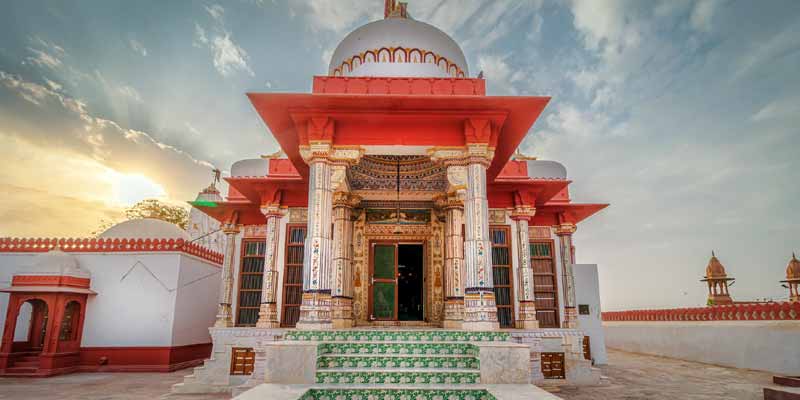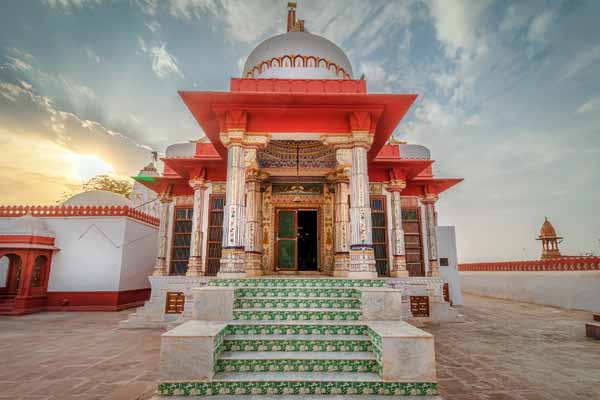Shri Laxminath Temple, situated in the heart of Bikaner, Rajasthan, is one of the oldest and most revered temples in the region, with its foundations dating back to the 15th century. Dedicated to Lord Vishnu (Laxminath) and his consort, Goddess Lakshmi, this temple is a pivotal center of devotion, drawing pilgrims and tourists alike with its spiritual ambiance and architectural beauty.
Constructed by Rao Lunkaran, and later developed by Maharaja Ganga Singh, the temple showcases an exquisite blend of Rajputana and Mughal architectural styles. The intricate carvings, magnificent silver doors, and the beautifully adorned idols of Lord Vishnu and Goddess Lakshmi captivate the hearts of devotees. The temple premises are spacious, offering a serene atmosphere for prayer and meditation.
The festival of Janmashtami, marking the birth of Lord Krishna (an avatar of Vishnu), and Diwali, the festival of lights, are celebrated here with great fervor. Devotees gather in large numbers to offer prayers, sing hymns, and witness the splendid decorations illuminating the Shri Laxminath Temple.
Shri Laxminath Temple is not just a place of worship but a beacon of cultural heritage and spirituality in Bikaner, preserving the sanctity and traditions of Hindu religion across centuries. Its divine aura and historical significance make it a must-visit destination for those seeking spiritual solace and insight into Rajasthan’s rich cultural tapestry Bikaner Tour Planner.

History of Laxminath Temple, Bikaner
The Shri Laxminath Temple, nestled in the vibrant city of Bikaner, Rajasthan, is a testament to the city’s rich cultural and spiritual heritage. Its origins trace back to the 15th century, making it one of the oldest temples in the area dedicated to Lord Vishnu (Laxminath) and his consort, Goddess Lakshmi. The temple stands as a symbol of devotion and architectural grandeur, embodying the spiritual heart of Bikaner.
Founded by Rao Lunkaran, the temple’s construction highlights the profound devotion of Bikaner’s rulers to Lord Vishnu and Goddess Lakshmi. Over the years, the temple has witnessed numerous expansions and enhancements, notably under the patronage of Maharaja Ganga Singh, who played a pivotal role in enriching its architectural and spiritual legacy. The temple beautifully encapsulates the essence of Rajputana and Mughal architectural styles, reflecting the historical epochs it has survived and thrived through Bikaner Tour Packages.
The facade and interiors of the temple are adorned with intricate carvings, majestic silver doors, and elaborate decorations, which not only enhance its aesthetic appeal but also serve as a focal point for the devout. The sanctum sanctorum houses the revered idols of Lord Vishnu and Goddess Lakshmi, drawing devotees from far and wide to seek blessings.
Significant Hindu festivals, such as Janmashtami and Diwali, are celebrated with great zeal at Shri Laxminath Temple. These festivals see the temple premises beautifully illuminated and adorned, attracting throngs of devotees and tourists who gather to partake in the rituals, prayers, and cultural programs, creating an ambiance of devotion and communal harmony.
Over the centuries, the Laxminath Temple has not only been a place of worship but also a custodian of the region’s cultural and religious traditions. It stands as a beacon of faith, attracting pilgrims seeking spiritual solace and individuals interested in experiencing the historical and cultural richness of Bikaner. The temple’s enduring legacy continues to foster a sense of unity and spiritual well-being among its visitors, making it an invaluable jewel in Rajasthan’s crown Shri Laxminath Temple.
Places To Visit Near Shri Laxminath Temple
Bikaner, a city steeped in history and culture in the heart of Rajasthan, India, is home to the revered Shri Laxminath Temple. This temple, while a significant attraction in its own right, is surrounded by numerous other sites of interest that offer visitors a deeper insight into the region’s rich heritage. Here are some must-visit places near Shri Laxminath Temple:
Junagarh Fort: Just a short distance from the temple, Junagarh Fort is a magnificent example of Rajput architecture and one of the few forts in Rajasthan not built on a hilltop. The fort’s palaces, courtyards, and museums display an array of artifacts that narrate Bikaner’s history.
Karni Mata Temple: Located about 30 km from Bikaner, this temple is famous for the thousands of black rats that reside here, considered sacred and worshipped. The temple offers a unique cultural experience that’s both intriguing and spiritual Shri Laxminath Temple.
National Research Centre on Camel: This one-of-a-kind research center is dedicated to the study of camels, offering insights into their breeding and management. Visitors can enjoy camel rides, sample camel milk products, and learn about the significant role camels play in Rajasthani culture.
Rampuria Haveli: Known for its stunning architecture, the Rampuria Haveli is a cluster of mansions built by wealthy merchants. The intricate designs and the red sandstone construction make it a photographer’s delight and a peek into the opulent lifestyle of Bikaner’s merchants Shri Laxminath Temple.
Ganga Government Museum (Ganga Golden Jubilee Museum): This museum houses a rich collection of artifacts, including pottery, paintings, weapons, and coins, offering a glimpse into the historical and cultural heritage of Rajasthan.
Best Time to Visit Laxminath Temple
December to March is the ideal time to plan your vacation in Bikaner. This winter brings a fantastic climate that allows you to enjoy sightseeing in the city easily. Summer brings hot weather, whereas monsoon is responsible for increasing humidity. Moreover, to experience the full glory of Shri Laxminath Temple, visit during Ram Navami, Janmashtami, Geeta Jayanti¸, Diwali, and Nirjala Ekadashi.
How to Reach Shri Laxminath Temple
Being settled in the middle of Bikaner, it is easily accessible from any point in this city. Transport services in this city are good and offer various commuting options between your destinations to this temple. Auto rickshaws, rental cars, mini buses, and taxis are available in this city. However, this temple is 3 km from the Bikaner Railway junction and 4 km from the famous Junagarh Fort. Apart from that, the precise location of this temple is Vaidya Mangaram Colony, which is easily accessible as it is one of the oldest shrines in this city.
By Air: The nearest airport to Bikaner is the Jodhpur Airport, which is around 250 kilometers away. From there, you can take a taxi or bus to Bikaner.
By Train: Bikaner Junction Railway Station is well-connected to major cities like Delhi, Jaipur, Jodhpur, and others. Once you reach Bikaner by train, you can hire a taxi, auto-rickshaw, or use public transport to reach Shri Laxminath Temple.
By Road: Bikaner is well-connected by roads to major cities in Rajasthan and neighboring states. You can either drive your own vehicle or take a bus from nearby cities like Jaipur, Jodhpur, or Delhi. Once you reach Bikaner, you can hire a taxi, auto-rickshaw, or use public transport to reach the Shri Laxminath Temple.
